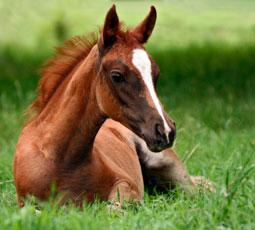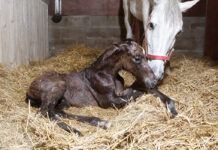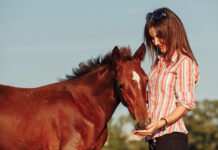
The outcome of most births in the equine world will end with a healthy foal. However once in a while things go awry and for one reason or another a foal is orphaned. Compared to a typical foal, a newborn orphan demands additional attention to ensure a good chance of survival.
“Due to the type of placentation that a mare has, there is very little ‘antibody’ transfer to the fetus in utero. Therefore it’s essential that, if at all possible, the orphan receives his dam’s ‘first milk’, or colostrum,” says Dacelle Peckler, DVM, of Danville, Kentucky.
“Preferably I like a foal to receive colostrum within four hours of birth; however it may still be administered up to 12 hours after foaling with good results,” says Dr. Peckler. For the first six hours of an orphan foal’s life it should be bottle-fed about 250 ml of colostrum every hour, for a total of 1.5 to 2 liters. Should you fail to supply colostrum to the foal, you still have another option. “When the foal is past the window for oral colostrum, equine immunoglobulin can be administered in the form of IV plasma,” says Dr. Peckler.
After treating the foal’s navel stump, it is essential to assess your foal’s health status. “Check his heart rate, respiration, gastrointestinal motility, and most importantly, his temperature,” says Dr. Peckler. “Record morning and evening vital signs for the first few days, but at any sign of trouble, a quick temperature check will be important information to relay to your veterinarian.”
Approximately one hour following birth the foal’s temperature should be about 100.4 to 102 degrees Fahrenheit. Anything above or below this temperature is cause for concern, Dr. Peckler adds, “even if your foal is behaving normally, he will likely need veterinary intervention.” If your orphan becomes lethargic, lacks an interest in eating, or shows any sign of lameness, call your vet.
Once immediate care of the orphan has been met you will need to turn your attention to supplying him some sort of nourishment around the clock. With the help of your vet, a local breeding farm, or a veterinary university, a gentle nurse mare may be located and would be the ideal feeding situation. However, orphan foals will also do fine on commercial mare’s milk replacement products, as well as on homemade brews of 1 to 2 teaspoons of honey or white corn syrup to 8 ounces of 2 percent cow’s milk.
Due to a foal’s natural suckling instinct, feeding the orphan with a bottle and lamb’s nipple should be relatively easy. For those fussy foals, dipping the nipple into a little Karo Syrup will help encourage acceptance of the rubber nipple. However, you may eventually want to teach the foal to drink from a bucket, which will make feedings easier when he begins to consume larger quantities of milk.
For the first five days of your orphan’s life he should be fed around the clock every hour, and should consume about 330 ml per feeding. As your foal grows you will need to increase the total amount of nourishment per feeding, but will also be able to lengthen the time between each feeding. Ask your veterinarian for a schedule that will keep your foal healthy and growing.
With the help of an alert and involved owner, orphan foals can survive and are very capable of growing into future serviceable mounts.
Identical twins Kim and Kari Baker work as a free-lance writing/photography team and raise Appaloosas on their Montana ranch.







Great advice.